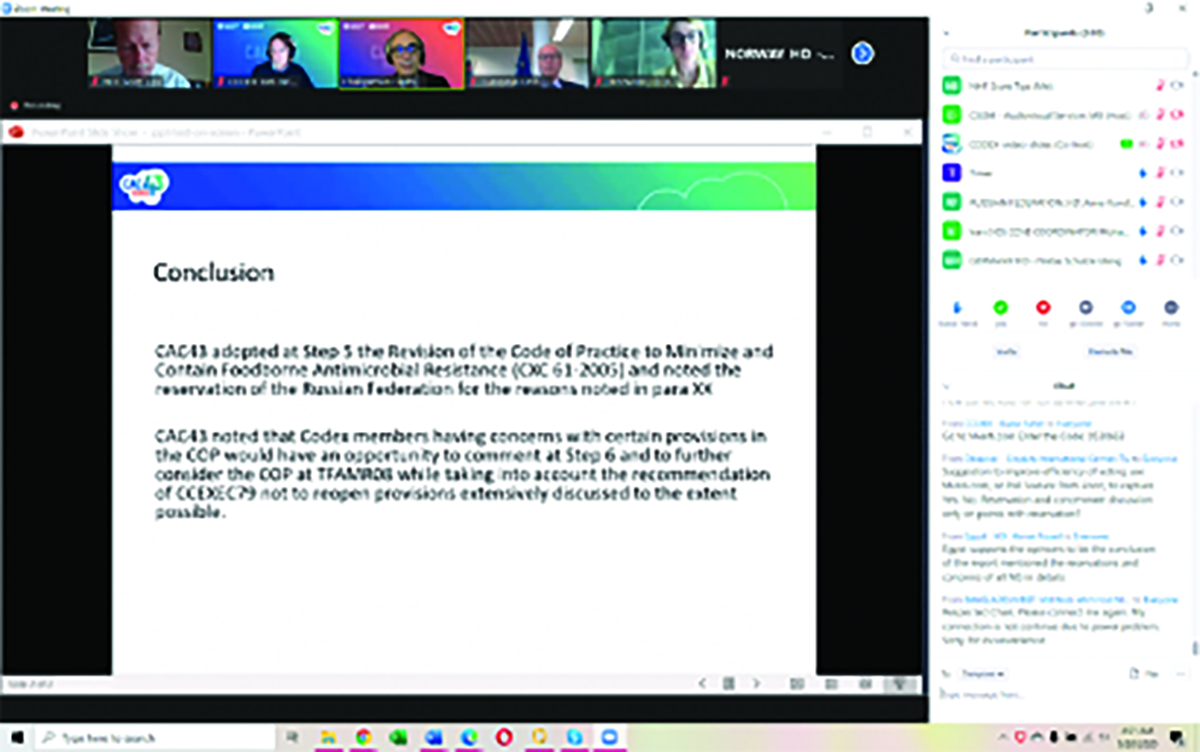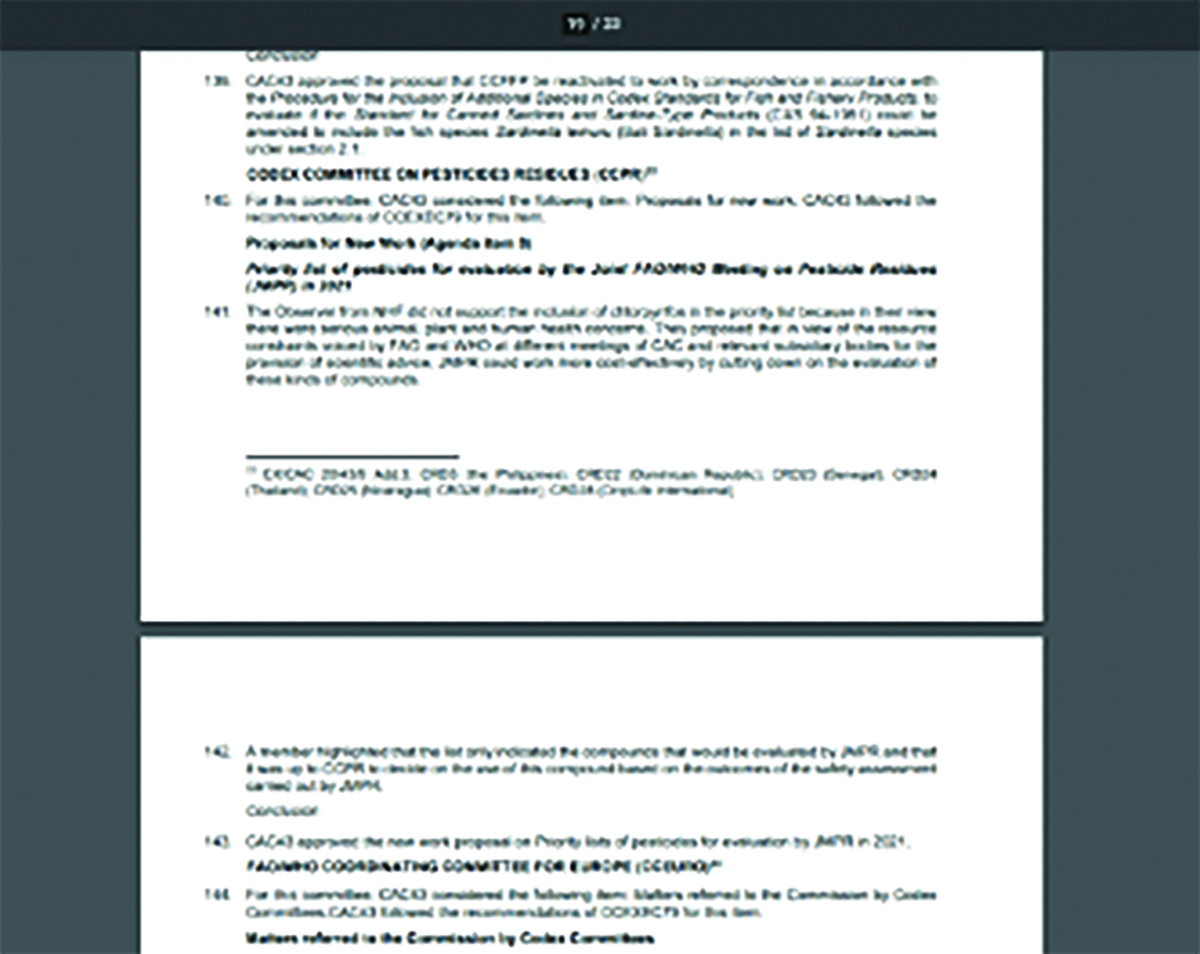Note: The views and opinions expressed here are those of the author(s) and contributor(s) and do not necessarily reflect those of the publisher and editors of WholeFoods Magazine.
With governments around the World still raising the alarm over the COVID-19 pandemic even well into the year 2020, the Codex Alimentarius Commission (CAC) was sufficiently alarmed as to yet further delay all of its in-person meetings. The schedule changes for Codex were enormous.

Cancelled Meetings After much deliberation by the CAC Executive Committee, the late Spring and Summer 2020 meetings that had already been taken off calendar—including the meetings of the Codex Committee on General Principles in Bordeaux, France, the Codex Committee on Contaminants in Foods in Utrecht, the Netherlands, the Codex Committee on Residues of Veterinary Drugs in Foods meeting in San Diego, California, and even the July 2020 Codex Alimentarius Commission meeting in Rome, Italy—were further postponed. Given the media and public-health officials’ alarm raised then, the Commission acted cautiously and prudently.
Moreover, many meetings were cancelled by Codex simply because several of the host countries for those meetings had implemented travel restrictions, or even complete travel bans, that would have prevented many, if not all, foreign Codex-member country delegates from personally attending those meetings. So, Codex felt compelled to cancel all of its in-person meetings in 2020, which meant that from having held physical meetings on 150 days in 20 different countries during 2018-2019, Codex held physical meetings on only 5 days in all of 2020!
The big question mark was how and when the 43rdSession of the Codex Alimentarius Commission itself would be held. Normally, these well-attended meetings are held in alternating years in Rome, Italy (FAO headquarters) and Geneva, Switzerland (WHO headquarters). The year 2020 was to have been the year for the CAC meeting to be held in Rome.
However, the alarm over COVID-19 made sure that this would not happen; so, the Codex Secretariat went into high gear and organized avirtualCAC meeting for more than 600 delegates. This meeting was scheduled to take place on September 24-26, 2020, and then, after a two-week pause, again on October 12th and 19th for its concluding sessions. As it happened, this schedule was prolonged.
The Virtual Meeting On September 24, 2020, as NHF’s delegate, I—along with 616 other Codex delegates and attendees from around the World—used Zoom to convene for that first day of the virtual CAC meeting. Because of the problem with 24 different time zones for the planet-wide delegates, the meeting would only run for three hours a day, that is, from 12:00 noon until 3:00 p.m., Central European Time. Still, this timing proved to be difficult for many delegates. California-based delegates, for instance, had to be awake at 3:00 a.m. local time for the start of the meeting, which would then last until 6:00 a.m. For one of those meetings, I was California-based, so I experienced first-hand how inconvenient it could be to attend. But, as Codex Secretary Tom Heilandt pointed out, on the flip side, those same delegates would benefit by not having to suffer from the jet lag of flying to Europe for this CAC meeting. Without a doubt, holding a virtual meeting in place of an expensive, in-person meeting in Rome will also save Codex much money.
I myself logged on to the meeting early and it was a good thing that I had, because Zoom had a strict 500-attendee limit imposed for this meeting and a good number of country- delegation heads were frantically messaging the Codex Secretariat that they could not log on. Before the opening speeches were all finished, the Codex Secretariat had sorted the problem out by increasing the limit to one thousand attendees.
A Smörgåsbord of Issues Despite all of the changes caused by the COVID-19 lockdowns, there was still a wide array of texts, standards, and guidelines for the delegates to discuss and agree upon, if possible. Among them were the final adoption of regional standards covering cassava-based products and freshGnetum spp. leaves as well as a regional standard in Africa for dried meat. Only the last one attracted much interest and that was mainly because certain delegations such as Argentina and several other Latin American countries wanted to be involved in the discussion. So, ironically enough, the discussion on just the discussion rights took considerable time.
Then, in rapid-fire succession, the Commission adopted as new work a regional standard for kava beverages, soybean products fermented withBacillus species, noni-fermented drinks, quick-frozen dumplings, and cooked rice wrapped in plant leaves. Who would have thought that Codex would ever create standards for such a diverse range of prepared food? But it does.
As it has created standards for fresh garlic, kiwifruit, ware potatoes, yams, and food-allergen management by business operators. All of these standards were adopted as final by Codex and there were no battles over them.
The Follow-up Formula Standard There was, however, a battle over one particular hot-potato issue, the Follow-up Formula (FUF) standard; and this meeting was no exception to the many, previous meetings at which this standard has been debated. The darling-favorite of the infant-formula industry crowd and thebête noireof the consumer organizations that flock every year to Codex specifically to wrestle over this issue, the FUF standard invariably consumes vast amounts of Codex time. The International Baby Food Action Network (IBFAN) and the European Network of Childbirth Associations (ENCA), as well as other similar infant-formula-oriented consumer Codex INGOs, have been fighting a steady, rear-guard action on this standard, essentially arguing that the FUF standard is fake, unnecessary, and misleading. It is, they say, simply a money-making scheme hatched by greedy manufacturers who want to extend the infant-formula market into the baby’s later years when, instead, the baby has become a growing infant who still needs mother’s milk and an increasing supply of nutritious, native foods and not some factory-made, one-size-fits-all, corporate formula.
ENCA and IBFAN especially decry the labeling of Follow-up Formula to mimic infant-baby formula so that uneducated and often illiterate mothers will be misled into believing that FUF is a natural progression in their child’s diet. They also ask, along with India, that the international resolutions of the World Health Organization (WHO) and the World Health Assembly (WHA) concerning infant-baby formula be included within the Scope section of this Codex standard. Yet, each year the FUF standard supported by industry advances incrementally towards adoption despite all objections, which are sometimes dutifully noted in the Final Report of the meetings. This year was no different with the standard’s Section B covering the proposed draft Scope, Definition, and labeling being advanced by Codex up the 8-step ladder towards adoption at Step 5.
RUTFs One of Codex’s noble goals is to establish guidelines for healthy Ready-to-Use Therapeutic Foods (RUTFs), which are used to feed severely malnourished children (usually under the age of five). RUTFs are energy-dense, micronutrient-enriched pastes (similar in consistency to peanut butter) that are nutritionally similar to the traditional milk-based diet used in inpatient therapeutic feeding programs. Often, RUTFs consist of peanuts, oil, sugar, and milk powder. Some of the ingredients are not what we would consider optimally healthy (certain oils and sugar) but the RUTFs do give an immediate sustenance to children who would otherwise die. At this meeting, the Commission agreed to advance the draft Guidelines for RUTFs up the 8-step ladder towards their final adoption.
At the last meeting of the Codex Committee on Nutrition and Foods for Special Dietary Uses (CCNFSDU), held in 2019, where the RUTFs are discussed, NHF had successfully expressed to the CCNFSDU delegates NHF’s concern over the high ratio of calcium to magnesium (55mg to 15mg) as well as over the generally low minimum and maximum levels being set for magnesium, reminding everyone that extensive science supporting higher levels exists and had been previously submitted to CCNFSDU. I then proposed that the levels for magnesium be doubled to be closer to the proposed values for calcium. That suggestion was provisionally accepted. At next year’s CCNFSDU meeting, however, NHF will have to reiterate the science supporting its position on magnesium levels.
Discontinued Work on TFAs & Biofortification For the last several years, the CCNFSDU had been crafting a definition for Biofortification. Once adopted, that definition would then be used uniformly around the World to apply to those foodsconventionally fortifiedwith higher levels of nutrients and everyone would be on the same page whenever the term “biofortified” was used. Indeed, the NHF was an early supporter at Codex ofthisdefinition.
However, the pro-GMO forces hijacked the draft definition so they could then dishonestly hide their genetically engineered foods within this definition and use its appealing, natural-sounding name to sell their GMO foods to unsuspecting consumerson a worldwide scale. If Codex were to allow “any method of production” and “any source” to be part of the Biofortification definition, as had been proposed, then that definition would promotemarketing deceptionof the worst sort. So, NHF naturally raised the alarm at Codex over this and consistently opposed the adoption of this misleading and deceptive definition.
Fortunately, at its last meeting (2019), the Codex Nutrition Committee discontinued its work on the definition, an act that needed to be ratified by the parent-body Commission at its virtual meeting this year. And so, it was. Therefore, the attempt to create a misleading definition for Biofortification that would include genetically engineered foods has been officially buried and this CAC43 meeting constituted, in large part, its funeral.
Similarly, CAC43 discontinued the work on a condition for a claim for “free of” Trans Fatty Acids (TFAs), and in view of the importance of addressing TFAs nutritionally, the Commission noted that other committees such as the Codex Committee on Food Labelling and the Codex Committee on Fats and Oils could consider risk-management options instead to address the dangers of TFAs in food.

Courtesy of Scott C. Tips
Foodborne Antimicrobial Resistance By the third day of the meeting (September 26, 2020), the number of participants had dwindled to 542, yielding their right to weigh in on one of the most important discussions. Because of its importance, this agenda item was a lengthy one. Discussion on the draft Code of Practice for foodborne Antimicrobial Resistance (AMR) ran from 12 noon until 3:00 p.m., that is, for the full three hours allocated for the meeting that day. Mostly, the debate centered upon how much of the draft language worked out among the delegates at prior meetings would still be left open for discussion at future meetings. Russia primarily—and the European Union (EU), Norway, and the NHF secondarily—opposed the adoption of the AMR Code of Practice at Step 5. Russia noted that “AMR had been a global challenge for many years and the emergency to resolve this issue continued to date. Although acknowledging that a lot of progress had been made during the revision of the CoP, there were still key provisions in the text, such as principles and definitions, that allowed for routine (prophylactic) use of critically important antimicrobials, which posed a risk to human health. Therefore, it would not be prudent to forward the CoP to the next step without having further debated such issues at TFAMR08 [Task Force on Anti-Microbial Resistance, Meeting 8].”
Russia reaffirmed its view that the use of medically important antimicrobials should be restricted totreatment only. The EU, Norway, NHF, and ENCA supported this view, while the United States and many other delegations that routinely use antibiotics as growth promoters in animal husbandry opposed Russia’s sensible and pro-health position. At one point, NHF reminded Russia to formally ask the Codex Secretariat that its important remarks be included in the Final Report. Russia then did just that, or else its position on the issue would have vanished as if never made at the meeting. The debate over the wording of this Code of Practice will continue in the Task Force meetings to come.
Sauces and Pesticides After a 16-day hiatus, and with its attendance having slipped down to 485 participants, the CAC43 meeting readjourned on October 12, 2020, and quickly disposed of a number of draft standards dealing with the grain size of quinoa, chili sauce, mango chutney, dried fruits, pickled cucumbers, canned bamboo shoots, and gochujang. The Codex Fish Committee was reactivated as well but is to meet “by correspondence only.”
With that out of the way, the Commission delegates then considered the addition of new work in the form of a “Priority List of Pesticides for Evaluation by JMPR [Joint FAO/WHO Meeting on Pesticide Residues],” which was one of the agenda items of most interest to the NHF. Unfortunately, at Codex, one learns that any working group chaired by Australia is headed for trouble since the Australian Codex Office is, in my opinion, nothing more than a regional branch office for the pesticide industry. Australia pushes greedy industry interests and does not ever seem to give a thought to protecting the health of even its own citizens, let alone the citizens of the World.
The priority lists established by this working group include a toxic brew of pesticides ranging the gamut from Isoflucypram (a Bayer fungicide sprayed on wheat, oats, and other cereal grains) and Chlormequat (an Eastman Chemical plant-growth regulator applied to wheat and barley) to Fludioxonil (a Syngenta fungicide used on papayas, mangos, and bananas) and Chlorpyrifos (a genotoxic pesticide long used around the World). Many of these pesticides have already been evaluated and revealed to have reproductive-toxicity issues, among many others. None of them have ever been evaluated for their synergistic effects with any or all of the other pesticides, herbicides, toxins, and contaminants in our foods.
The new work on the pesticide priority lists was going to be approved without any objection until I spoke up for NHF. As a test, I picked one of the most odious of the pesticides on the list—Chlorpyrifos—and asked to be recognized by the Chairman. Once given the floor, I told my virtual audience that, “Humanity is inundated with pesticides in increasing amounts every year. Chlorpyrifos, an organophosphate pesticide, is one of the nastier ones. Originally derived from nerve gas developed by Nazi Germany, it is now one of the most widely used agricultural pesticides in the United States. About 5 million pounds of it are sold each year. As a result, traces of the chemical are commonly found in drinking water, mothers’ milk, our bloodstream and urine, and the foods we all eat. Children and animals are especially vulnerable. The U.S. EPA’s biological evaluation of Chlorpyrifos found the pesticide is “likely to adversely affect” 1,778 of the 1,835 animals and plants accessed as part of its study, including critically endangered or threatened species. NHF therefore asks that Chlorpyrifos be removed from the list and any use,and that our concerns be reflected in the Report.”
Incredibly, not one other participant spoke out in support of our position. The new work was approved and the Commission moved on to its next discussion. Clearly, the Codex methodology is missing some vital factor necessary for insuring that toxic products such as these are not blithely unleashed upon humanity and the World.
The Codex COVID-19 Response On its fifth meeting day, October 19, 2020, the Commission discussed its “Intermediate Report of the Sub-committee of the Executive Committee of the Codex Alimentarius Commission—‘Codex and the Pandemic—Strategic Challenges and Opportunities.’” Of course, in its report, the subcommittee acknowledged the global health risks presented by the pandemic and stated that there still remained many challenges facing Codex as long as the risks continued, which would require “new tools” (e.g., virtual meetings) to be adopted so as to accommodate the changed conditions. It did, however, recommend that no more meetings be cancelled or postponed.
NHF responded to this COVID-19 report with its written comments that can be accessed either on the Codex website or the NHF website(https://thenhf.com/2020/10/12/nhfs-comments-on-covid-19-pandemic-crd-36/). NHF’s firm position as stated to the Codex delegates was, and still is, that the pandemic is over if one considers death rates instead of meaningless “case” counts. Therefore, we argued, there was no further need for postponing or cancelling in-person Codex meetings. Needless to say, this was the only such viewpoint expressed to the Codex delegates, at least by an accredited participant.
What the Future Holds The in-person Codex Committee on Residues of Veterinary Drugs in Foods (CCRVDF) “zilpaterol” meeting, previously scheduled to be held in Cleveland, Ohio in January 2021, was rescheduled to July 2021, in the same city. But given the ongoing claims of a pandemic and the possibility that a new U.S. President might impose yet further lockdowns and meeting restrictions on a restive populace, who can really say that even this Codex meeting in July will go forward as currently planned? Meanwhile, NHF has warned you about eating meat doped up with steroid-like vet drugs.
At the previous vet-drug committee meeting in early 2018, NHF was able to stop the zilpaterol standard from progressing up the eight-step ladder to final adoption. On behalf of NHF, and consumers worldwide, I argued then that Merck’s vet drug zilpaterol, which is nothing more than a non-therapeutic vet drug for animal weight gain (and thus increased revenue), unnecessarily tortures cattle and other animals with unnatural weight gain, cardiovascular problems, and other horrific side effects all while poisoning humans with cumulative and unnecessary toxic drug residues to add to the long laundry list of other toxins and contaminants we are all exposed to on a daily basis. Next July, though, in Cleveland, Ohio, Merck will get another chance to poison the World, especially the animal kingdom and the humans who eat those animals.

Pluses and Minuses The final days of the CAC meeting were pushed back to November 5-6, 2020, when the reading and correction of the meeting’s draft Report were to be made. So, in all, this particular Codex Commission meeting lasted seven partial days spread out over a seven-week period. While that kind of scheduling is neither an advantage nor a disadvantage per se, it does highlight the difference between in-person, eight-hour meetings each day and virtual meetings that can only be held for three hours every day due to the 24 different time zones and the need to accommodate all delegates as much as possible.
As much as I may prefer in-person meetings for their human-contact advantages, I did come to see at least three major advantages from holding virtual Codex meetings: (1) no travel, and all related expenses and time taken for travel; (2) the opportunity for a much larger number of participants to be able to attend virtual meetings; and (3) the Zoom online chat system puts all delegates ininstantcommunication touch with both (a)allother delegates and staff so that one can express and share one’s concerns and viewpoints without interference, and (b) with any other single delegate so that you can pass messages privately and directly to just that person. This is a huge advantage over the clumsier, inter-person communications and broadcasts that occur when meeting in person, not to even mention being blocked at times from speaking by spiteful Codex chairmen or chairwomen.
NHF has argued for Codex to return to its previous manner of holding in-person meetings. However, Codex Secretary Tom Heilandt and many others influential at Codex believe that virtual meetings and meetings by correspondence will supplant the old system of meetings and that Codex may never fully revert to its in-person meetings. Sad to say, but the vibrant hub-bub of the old face-to-face meetings is being replaced by the muted interaction of digital hermits.WF










